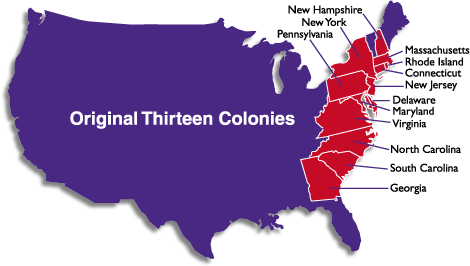-
Chapter 2: AMERICAN REVOLUTION
Renaissance
Era of questioning established beliefs. Every aspect of thoughts and beliefs were questioned. It was an intellectual revolution where all beliefs based on faith were questioned.Scientific revolution was seen and new ideas based on secularism and rationality were created. Hold of church over ideas was questioned. Division of people on the basis of birth were undermined. This period also became "Age of Enlightenment" or "Age of Reason".
Ideas of liberty, equality and fraternity became popular. National consciousness was created. This period also led to protest and overthrow of autocratic rule in many parts. A peoples revolution was seen that challenged privileges to a few. A new social order called Socialism emerged and democratic and republican system of government became a popular demand.
American Revolution
European countries started the race for colonies. They started exploring new territories with a view to colonize them. In North America colonies were set up by France, Holland, England and Spain.
By the middle of the 18th century there were 13 colonies in North America belonging to England. Landless peasants, people seeking religious freedom, traders, profiteers settled there. Bulk of the population was infant farmers. Small industries developed there of textiles.
In the North, fishing and ship building were the main occupation and in south slave labor was used to get tobacco and cotton plantation.The colonies had their assembly and each was elected by qualified voters. The assemblies enacted taxes and made local laws. But these worked under the authority of mother country.
By the 18th century, the colonists found the laws increasingly interfering and they resented it. The idea of an independent nation grew and a revolutionary war was started which culminated in the defeat of England. This was the "American War of Independence".

Fig 1: 13 colonies of America.
Causes of the American war of Independence
Economic causes
- The policies of England impeded trade and industry in every way. The colonists were forbidden to start industries of the own like iron and steel.
- Heavy import duties were put on goods of other countries forcing them to buy only English goods.
- Certain commodities could be sold only to England.
- Use of Non British ships were forbidden.
Rent
- English aristocrats prevent the farmers from moving to the west into new lands. They wanted the colonists to remain as rent payers to them.
Taxes to finance wars
- The continuous wars of English indebted them and so they wanted more revenues from colonies. They imposed a stamp tax on colonial transactions.
- A revenue stamp had to be affixed on all legal documents.
- This angered all colonists in many cities violent protests were seen and rioters even killed tax collectors.
- The colonists argued that since English parliament had no representative from colonies they had no right to impose taxes on them. The taxes were used for welfare of British not the colonists.
- American thinkers like Thomas Jefferson influenced by English and French thinkers too decided too fuel people desire for independence.
- The Americans then came up with the slogan "No taxation without Representation". The protestors forced England to withdraw stamp tax but English continued to assert right to levy taxes and it put tax on consumer goods.
- This incensed the colonists and they boycotted British imports. The British then withdrew the taxes but kept the tax on tea only. Boston Tea Party was a result of this action, protestors offloaded tea cartons on a ship at Boston port. The British then closed the port to trade.
Final Stage - Declaration of Independence
The representatives of 13 colonies met at the First continental congress at Philadelphia in 1774. They urged the king to not impose any taxes without their consent. But the king considered this act as mutiny and sent troops to rush the revolt.
The colonists then formed an army with help of local militias and other colonial powers. The colonists now fought for their right to form an independent nation , earlier they had fought for their right to be treated as Englishmen.
The declaration of Independence at Second congress was "All men are created equal".
The English army fought the American militia. The militia were familiar with the terrain and had help from other colonial powers who wanted to embarrass the British. British too were facing rebellion from Irish at home also few in the Parliament were against war on colonists. Thus, the British lost the war and General Cornwallis surrendered in 1781.
A Treaty of Paris was signed in 1783 declaring American independence.
American Constitution
The American colonies fought with separate army, finances, boundaries but at the end Formed the United States. They came together at the Philadelphia convention to form a constitution. This was enforced since 1789.
The US constitution was a federal system which divided powers between Center and states. Due to Jefferson and his followers work Bill of Rights were added by 10 amendments to the constitution.
The US became the oldest democracy of the world and the first to setup a republican government when most others were monarchy's. The US constitution too was the oldest written constitution that is enforced even today.
Aftermath of the Revolution
The Democracy wasn't a complete democracy as only propertied class had the vote. American Negros's were still enslaved, women had no voting rights. However the campaign to end slavery led to the civil war between Northern states and Southern states. This ended in victory for the North and slavery was abolished in 1865.
American war also inspired the French revolution as the soldiers that had achieved victory in America were inspired to free France from oppression of King.